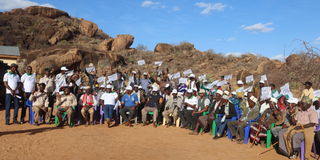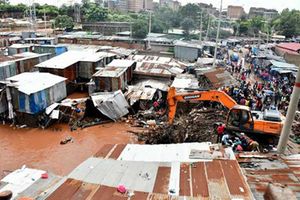Drought helps reconcile Gabbra and Borana communities in Marsabit

Borana and Gabbra community elders alongside peace stakeholders celebrate International Day of Peace on September 21, 2022 at Elle Borr Village in Sololo sub-county.
For over a decade now, Marsabit County has witnessed a series of mind-bending hostilities and ethnic killings between the antagonistic Borana and Gabbra communities.
However, with fatigue from perennial disasters and crises, the cynical and antisocial residents blamed for the hostilities seem to be pulling back.
Despite the negative effects of the ongoing drought, it is also seen as spreading kindness, hope and even charity in the county.
Speaking in Elle Borr, Moyale constituency, during celebrations to mark the International Day of Peace, members of the erstwhile antagonistic Borana and Gabbra communities affirmed that disasters and crises can bring even the greatest enemies together.
Uran Assistant County Commissioner Ayub Warui was awed that the two communities that had been at loggerheads for the five years he has been in the region finally agreed to silence the guns.
“Since I came to this county in 2017, I have always witnessed nothing but constant clashes and killing among the Gabbra and Borana communities,” Mr Warui said.
“But today we have a new dawn where the two communities have expressed the burning desire to put their differences aside and live cohesively.”
He cited the ravaging drought as one of the factors that prompted the communities to bury their differences.
Because nearly all water pans and boreholes had dried up and grazing lands depleted, herders from the two sides had no other option but to agree to share the remaining scarce resources.

Borana and Gabbra community elders mark International Day of Peace on September 21, 2022 at Elle Borr Village in Sololo sub-county.
The drought has deprived Marsabit residents of over one million livestock and driven over 225,000 residents to the cusp of starvation.
Mr Warui was impressed when he witnessed Gabbra herders grazing their livestock past Uran, which is mainly inhabited by the Borana community while Borana herders also grazed their animals in perceived Gabbra zones.
This new development after several unfruitful peacebuilding programmes over the years, he said, indicated the beginning of a major transformation in the relationship between the two communities.
Residents have also vowed never to be used as pawns again by the political class, which exploits their vulnerability to help them stay politically relevant.
Mr Warui was optimistic that ongoing peacebuilding processes across the country would finally yield longstanding peace among warring communities.
Similar sentiments were expressed by Turbi Assistant County Commissioner Stephen Kiloi, who urged herders never to allow themselves to slide back to the bloody days.
During such calamities and crises, he said, herders from both sides suffer alike.
As 80 percent of the Marsabit population are pastoralists, the scramble over natural resources such as water and pasture is considered a key trigger of ethnic tension among them.
But since the September 2 peace pact between the Gabbra and Borana in Turbi town, new twists in events have been reported.
Marsabit human rights activist and writer Abraham Dalle also attributed the prolonged drought of over five seasons to recent robust conversations that have yielded positive results in peacebuilding.

Borana and Gabbra community elders alongside during International Day of Peace on September 21, 2022 at Elle Borr Village in Marsabit County.
He also said the dusk-to-dawn curfew and security operations in Marsabit since March had sparked conversations between Gabbra and Borana.
Residents used the crises to evaluate the magnitude of losses and suffering they had brought upon themselves.
He wanted such peace dialogues to be replicated in other communities and between local politicians and peace stakeholders.
“We’re not yet out of the woods in terms of establishing longstanding peace as it is still fragile,” Mr Dalle said.
“This is just the beginning, but we’re hopeful going by the events that these discussions will yield long-term peaceful coexistence among the antagonistic communities."
Before the peace pact, most of the areas once deserted due to ethnic tension are now roaring back to life.
Elle Borr resident Guyo Ali narrated how the small village with over 300 households was completely deserted for nearly two years.
But since the beginning of the peace dialogues, residents have returned to their homes and are trying to rebuild their lives.
Gabbra family
Sololo peace chairperson Diba Galgallo said he can now visit or even spend a night at the home of a Gabbra family, unlike in previous years when they could never see eye to eye.
Turbi resident Chukulis Kuyowa, for her part, thanked God for the calm they now enjoy after massive losses caused by ethnic conflicts.
She called for goodwill from all partners to ensure longstanding peace returned to the entire county.
The peace dialogue in Elle Borr village brought together the Borana and Gabbra from Turbi, Sololo, and Uran divisions and was funded by the German government through Welt Hunger Hilfe and implemented by the Pastoralist Community Initiative and Development Assistance (Pacida).
Pacida programme manager Samuel Lentoror said it was ironic that the two communities were coming together during hard times.
“It’s awestriking to see these two communities agreeing to bury their differences, especially during these hard times, and to share the scarce resources when indeed it is the scramble for the same resources that had caused them to be constantly at loggerheads,” Mr Lentoror said.
The two communities previously clashed because of the scarce resources, but they finally decided to share the few available resources even under the worst circumstances when droughts hit hard.
He said the ultimate change of mind could be a result of the need for survival as the two communities realised they could no longer keep fighting.
Peacebuilding process
Welt Hunger Hilfe project head Philip Ewoton clarified the peacebuilding process was a three-year programme aimed at building resilience among the pastoralists.
The success of the programme, he said, only lay in finding peace among the warring communities in Marsabit and on the Ethiopia-Kenya borders.
According to the Delaware Disaster Research Centre, after conducting over 700 field studies on floods, droughts and earthquakes, it was established that the vast majority of people sit calm and help each other amid calamities and disasters.
A British social psychologist also noted that people are much more likely to see prosocial behaviour across multiple types of disasters and extreme events.
Social connection may be particularly important under stress because stress naturally leads to a sense of vulnerability and loss of control.
Another study by Benjamin Converse and colleagues at the University of Virginia found that feeling out of control leads to greater generosity and helpfulness.
Other research also established that wars and stress lead to bonding.
Robert Sapolsky established from his research that acute stress prepares the body for resistance (physiological readiness, increased immune response, and heightened awareness).
Therefore, many scientists have agreed that acute stress, as unpleasant as it may be, could also be an opportunity to experience the most beautiful aspects of life: social connection and love.
Acute stress may help remind people of a fundamental truth: common humanity.
Understanding people’s shared vulnerability can also inspire kindness, connection and a desire to stand together and support each other.





